Good day friends…
This is an old thread but I came across something interesting and wanted to document and update this thread.
A friend just gave me a very old Peavey “Classic” amp. Per Enzo’s reply in #2, you would think this is the “Classic A” version. There are two Bright and two Normal inputs. BUT… I noticed the canned cap is marked with 40/40/20/20. Hmmm… seems odd. That is not reflective of Classic A. The filter caps in the Version A schematic call for something else. I then noticed the cap connections. Once again, it did not resemble Version A. In fact, it looks just like Version B. The only difference in what I have vs Version B is that one of the resistors is NOT a 400 ohm, it is a 1K ohm. Another minor discrepancy.
The second thing I looked at was the Bias circuit. The PC board I have has components that resemble Version A. For the Bias circuit, there is a 1K resistor, the 50K pot, and nothing after the pot. One leg goes to ground. I think you all agree we do not like seeing one end of the pot going to ground. We would prefer the Classic B approach. So, the amp has some Version A and some Version B circuitry.
The Version A schematic seems to show a switch on the rectifier diodes. Maybe a weird Standby switch? But neither A or B chassis ever had a Standby switch. Someone tried to install a Standby switch in my amp – bad mistake. I noticed he also wired up one side of the heaters to that switch. I will remove that switch.
Version B appears to show Flyback diodes on the output tubes. My amp does not have those.
One last thing I saw on the back of the chassis – there is a 3A stamp on the fuse. That was done with Version B.
So… when you “Need help identifying this amp”, the answer might be a skosh more complex that just looking at the inputs!!
It looks like I have a “tweener” version – perhaps it is a Classic A Plus!
I was told this amp sparked and had issues the last time it was turned on. So I will evaluate what I have to see if it is worth salvaging. If so, I think I will do the following:
- Remove the homemade standby switch and hard wire the heater to the output tubes.
- Buy a new canned cap and mimic the Version B circuit.
- Update the bias circuit to match Version B.
- Do I need to add some screen resistors? I need to understand why this amp did not use them. I have seen many other amps with no screen resistors.
- Maybe add some IN5408 Flyback diodes?
If I can save this amp (as a donation to an up and coming young musician), what changes might you make?
There you have it!
Peavey_Classic_A_Schematic.pdf
Peavey_Classic_B_Schematic.pdf
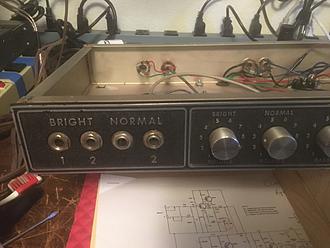
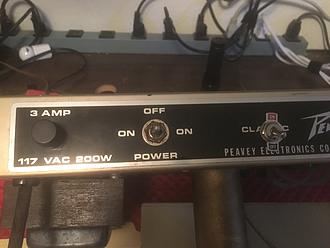

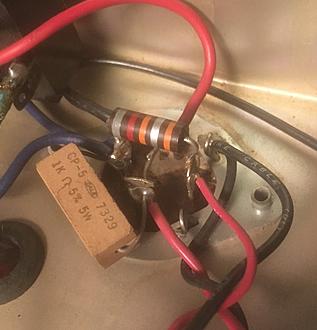
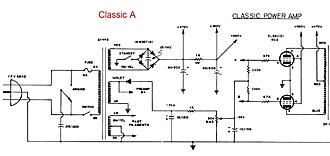
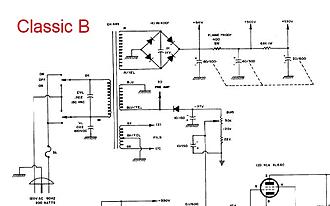
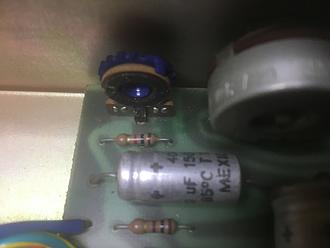
This is an old thread but I came across something interesting and wanted to document and update this thread.
A friend just gave me a very old Peavey “Classic” amp. Per Enzo’s reply in #2, you would think this is the “Classic A” version. There are two Bright and two Normal inputs. BUT… I noticed the canned cap is marked with 40/40/20/20. Hmmm… seems odd. That is not reflective of Classic A. The filter caps in the Version A schematic call for something else. I then noticed the cap connections. Once again, it did not resemble Version A. In fact, it looks just like Version B. The only difference in what I have vs Version B is that one of the resistors is NOT a 400 ohm, it is a 1K ohm. Another minor discrepancy.
The second thing I looked at was the Bias circuit. The PC board I have has components that resemble Version A. For the Bias circuit, there is a 1K resistor, the 50K pot, and nothing after the pot. One leg goes to ground. I think you all agree we do not like seeing one end of the pot going to ground. We would prefer the Classic B approach. So, the amp has some Version A and some Version B circuitry.
The Version A schematic seems to show a switch on the rectifier diodes. Maybe a weird Standby switch? But neither A or B chassis ever had a Standby switch. Someone tried to install a Standby switch in my amp – bad mistake. I noticed he also wired up one side of the heaters to that switch. I will remove that switch.
Version B appears to show Flyback diodes on the output tubes. My amp does not have those.
One last thing I saw on the back of the chassis – there is a 3A stamp on the fuse. That was done with Version B.
So… when you “Need help identifying this amp”, the answer might be a skosh more complex that just looking at the inputs!!
It looks like I have a “tweener” version – perhaps it is a Classic A Plus!
I was told this amp sparked and had issues the last time it was turned on. So I will evaluate what I have to see if it is worth salvaging. If so, I think I will do the following:
- Remove the homemade standby switch and hard wire the heater to the output tubes.
- Buy a new canned cap and mimic the Version B circuit.
- Update the bias circuit to match Version B.
- Do I need to add some screen resistors? I need to understand why this amp did not use them. I have seen many other amps with no screen resistors.
- Maybe add some IN5408 Flyback diodes?
If I can save this amp (as a donation to an up and coming young musician), what changes might you make?
There you have it!
Peavey_Classic_A_Schematic.pdf
Peavey_Classic_B_Schematic.pdf
Comment